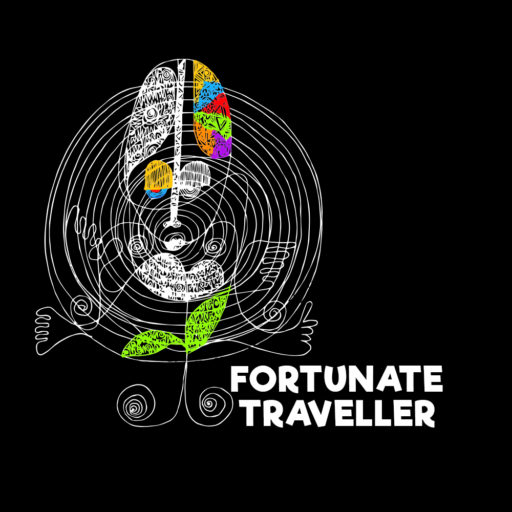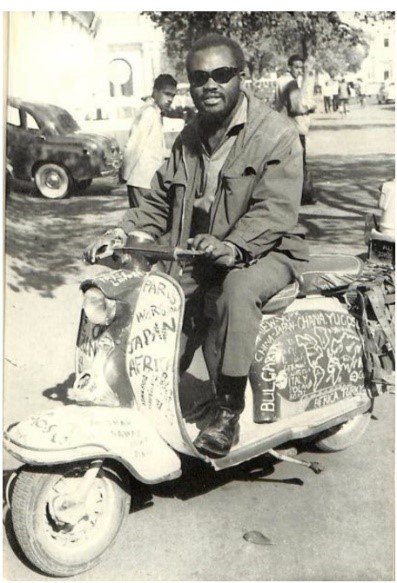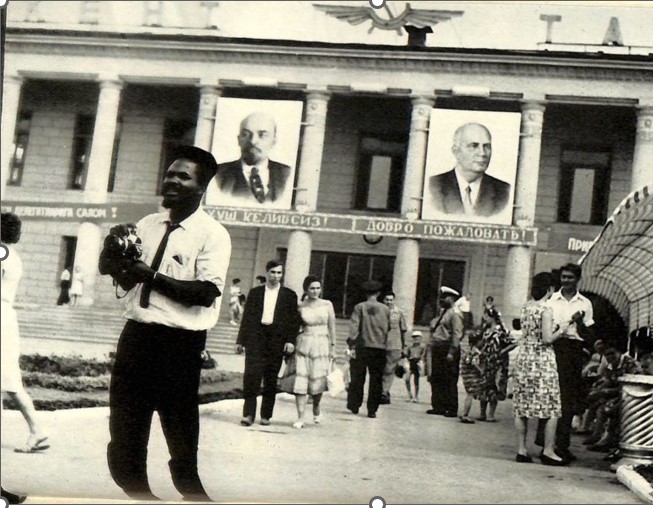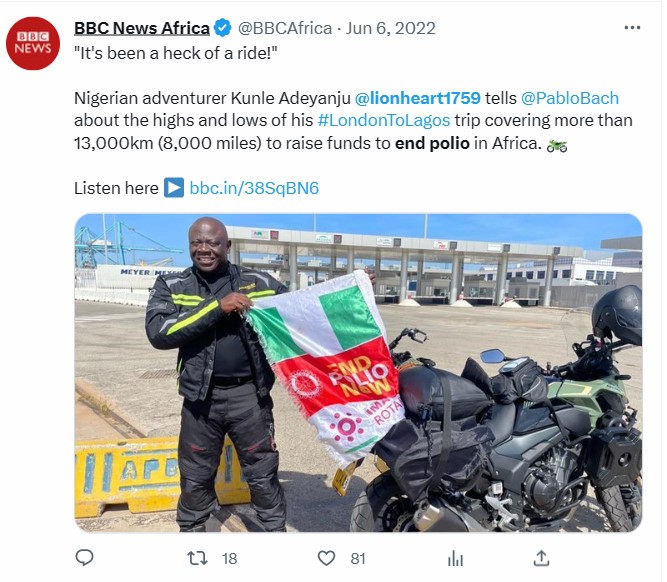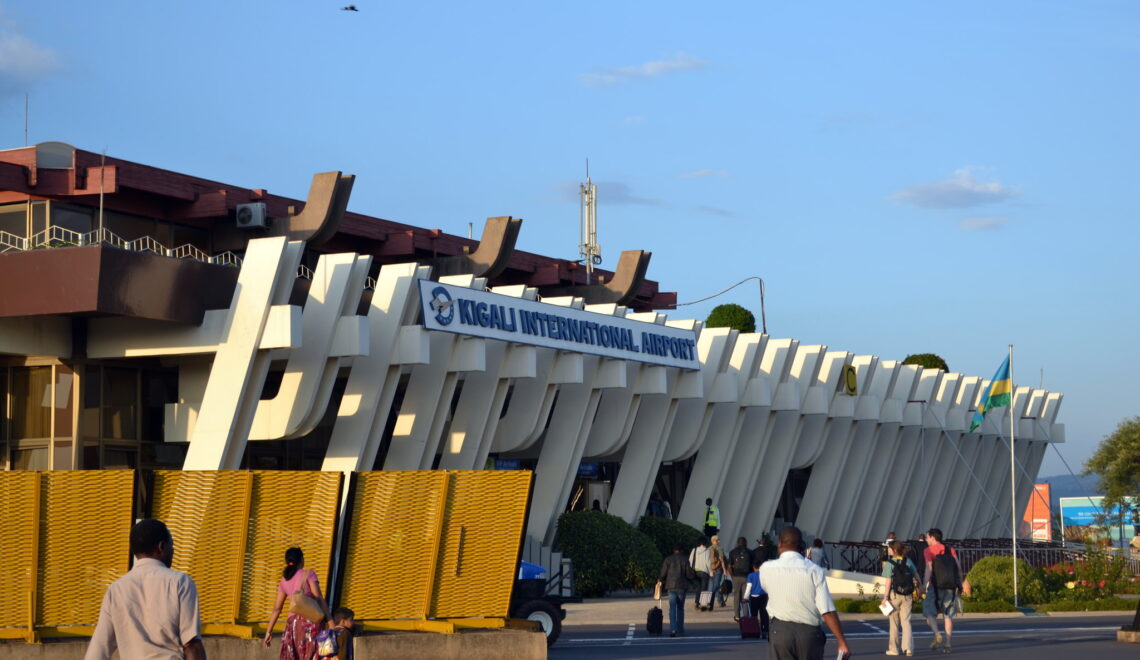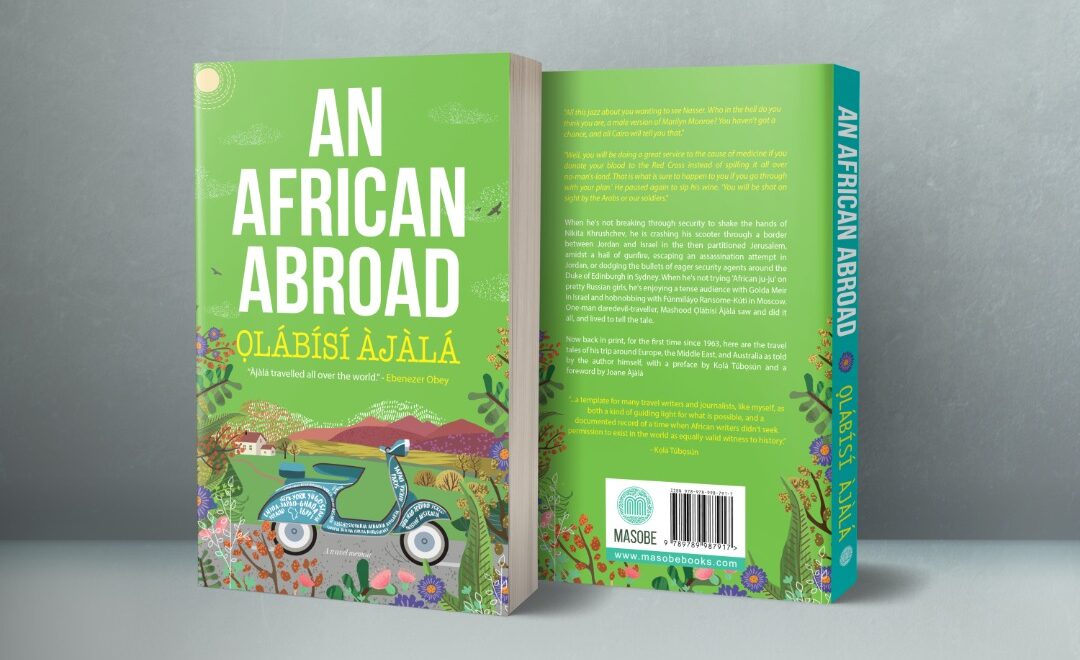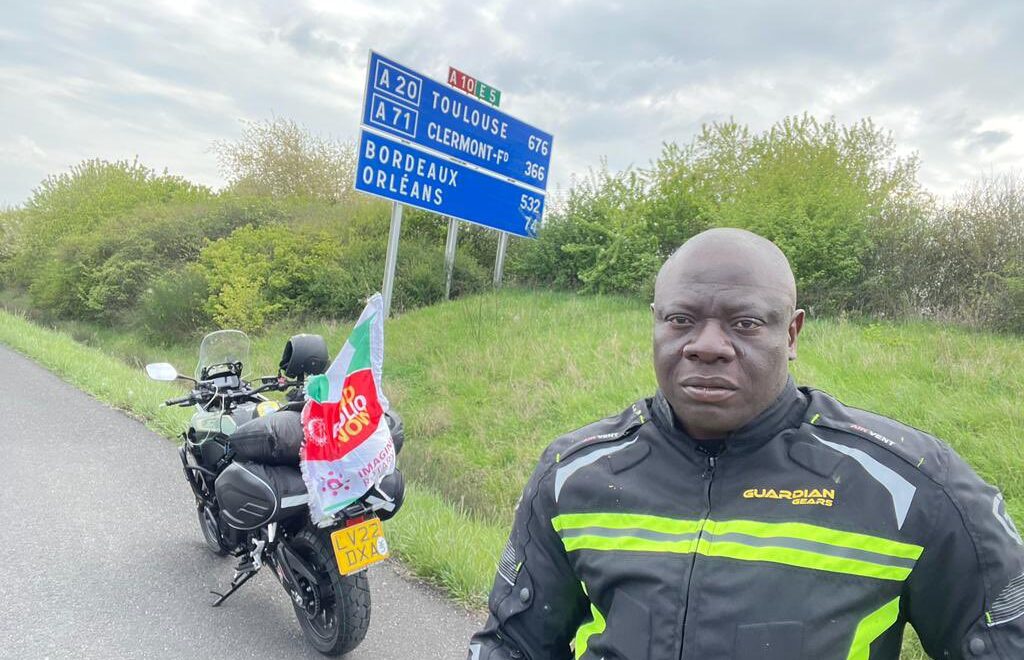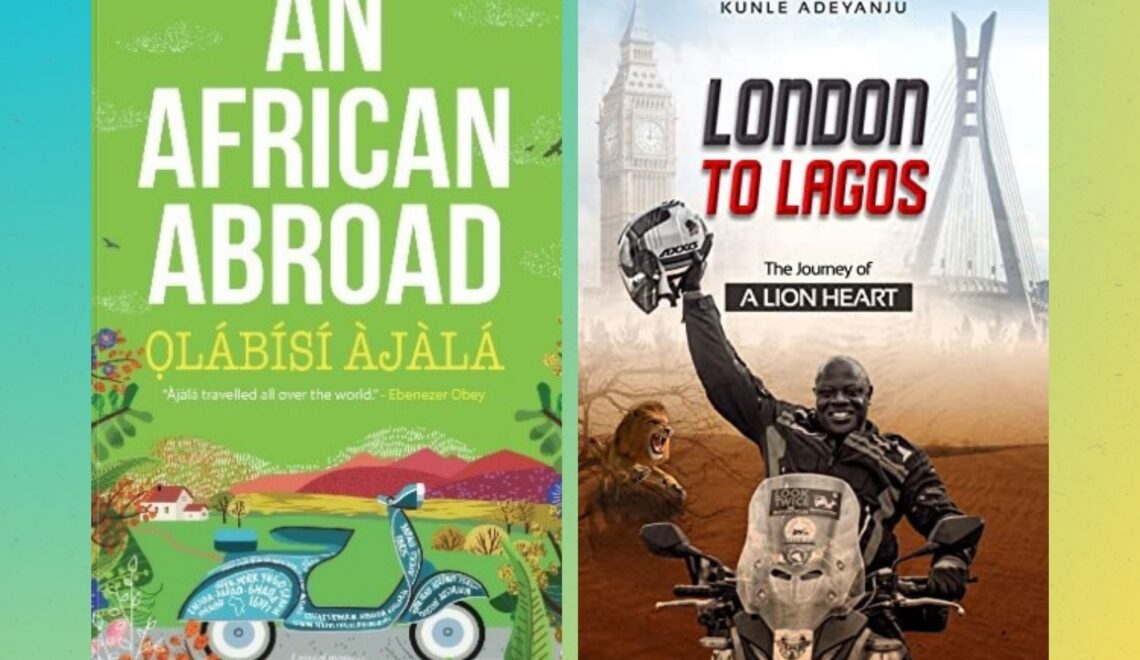
AN AFRICAN ABROAD by Ọlábísí Àjàlá (Author), Kọ́lá Túbọ̀sún (Preface), Tom Mboya (Introduction), Joane Ajala (Foreword), Masobe Books and Olongo Africa, 2022 [Originally published by Jarrolds:1963]
LONDON TO LAGOS: THE JOURNEY OF A LION HEART by David Kunle Adeyanju (Kindle Edition), 2022
Nigerian travellers have long been going places and crafting their travel stories, with no signs of slowing down. Recently relaunched is Moshood Ọlábísí Àjàlá’s travel memoir classic An African Abroad and, for the first time, David Kunle Adeyanju’s London to Lagos: The Journey of a Lion Heart. Both unfold on motorized wheels: Àjàlá on his 1960s Lambretta and Adeyanju on his Honda CB 500X. Reading them together makes for an adrenaline-fuelled ride and a splash of soul searching.
Motorbike travelogues have quite a history. The genre is more than a century old and has spun off in every direction. If over-privileged or wild-haired white biker-writer types still dominate the public imagination, then readers need to get out of their book circles more.
Àjàlá and Adeyanju have no truck with white adventurer mythology and get on with their own journeying and storytelling fifty years apart. What connects them across space and time is a shared grasp of their motorbike odysseys being part of bigger explorations. Determined to be on the move, they push themselves to new lengths. For both, the travel is about more than covering distance. It amounts to going the extra mile for themselves and for others. On the constantly shifting world stage, it is about signalling African resolve, reach, and choice.
Àjàlá, whose name has become synonymous in Nigeria with ‘traveller’, recounts that he went abroad initially to study against his father’s wishes to ‘achieve his ideas about his life and future’. To fund his travel, he worked as a hospital orderly, restaurant dishwasher, and morgue attendant while studying in the USA. He was able to kick start his solo ‘jaunt around the world’ in 1957, taking in 87 countries before reaching Australian shores in 1962. There he both found love and the opportunity to convert his notes into An African Abroad with the collaboration of his then new wife Joane.
An African Abroad takes the reader on a transfixing mid-20th-century ride through seven geographies. Each has a chapter dedicated to the country or region in focus: India, Russia, Iran, Middle East, Israel, Egypt, Australia. Against the odds, Àjàlá cuts across the globe on his signature Lambretta. There is never any thought of going quietly. The motor-scooter and his own personal drive do not lend themselves to that.
Àjàlá gains press coverage wherever he goes. He crosses seemingly impenetrable borders, braving gunfire at the Mendelbaum Gate between Jordan and Israel, for example. He secures meetings with numerous heads of state; in some cases, he literally launches himself into their sights where he can’t be ignored, in others he despatches his stories to do the work. In the mode of an international commentator, he relays seeing the best and worst of both ‘democracy and communism’. Unsettling easy divides, Àjàlá won’t be stopped.
He uses his journeying to confront fixities. Colonial legacies are a particular focus. Àjàlá visits a whites-only country club in Cairo, only to be beaten up, incarcerated, and deported before seeking redress with President Gamal Abdul Nasser himself. In Australia he challenges the authorities about its white settler policy.
The way in which this young Nigerian adventurer writes about traversing the globe opens windows into the late 1950s and early 60s as Western and Eastern blocs were vying for influence over Africa in both overt and insidious ways. The post-World-War era was complex and fraught, but change was in the air. Decolonisation was becoming a reality. As Àjàlá recounted through various episodes, racial prejudice was hard-wired into many regimes and societies, but the vision of a more integrated world was growing in places.
There is also a certain mobility that one can’t quite imagine today. You can’t help being struck by how Àjàlá gets around the world. Though not suggesting there was ease in Àjàlá’s day, the bureaucracy of mobility only seems to have swelled and sharpened in our post-9/11, post-Covid, protectionist age. The freedom of movement to travel internationally is obstructed for most, especially those from the Global South. Nationality, race, class, and other sociopolitical factors have significant effects on who gets to go. Achille Mbembe refers to the 21st-century’s preoccupation with ‘contraction, containment, incarceration and enclosure’. Anti-immigrant policies and weighted travel restrictions reveal a deep suspicion of peoples of colour on the move. Award-winning Nigerian travel writer and photographer Lola Akinmade Åkerström, who has been on the go since childhood, now based in Sweden, protests in her travelogue Due North (2017) that the ‘more visa stamps in my passport, the more my motives for travel have been deeply questioned’. “It’s a passport!” my inner voice yells’.
So what about borders for David Adeyanju in his 2022 travelogue London to Lagos? Nigerian businessman and humanitarian Adeyanju, now living in the UK, made a reverse trip to the country of his birth. He planned his multi-country route and paperwork meticulously in association with the charity Rotary International.
Traversing more than 17 borders, London to Lagos takes us on an audacious 13,000 km ride across plains, mountains, deserts, coastlines: UK – France – Spain – Morocco – Algeria – Western Sahara – Mauritania – Mali – Niger – Senegal – Guinea Bissau – Guinea – Sierra Leone – Liberia – Burkina Faso – Cote-d’Ivoire – Ghana – Togo – Benin – Nigeria. Very few countries on his route escape the ‘amber’ (‘exercise caution’) or ‘red’ (‘avoid’) categories issued by major travel advisories. For each border crossing, he needs a slew of documentation including Interpol confirmation of his bike’s registration. Carrying his 3-in-1 flag, he flies the colours of Nigeria, the ‘End Polio Now’ campaign, and Rotary International.
Like Àjàlá, he bunks down with everyday people, while making high-profile connections and magnetizing the media. He takes the public with him via the socials. Under his handle of @LionHeart1759, he keeps his global audience posted on his twists and turns. He is out to change the world. Specifically, he is going the distance to raise awareness and funding to stop polio.
London to Lagos is bold about its vision for the road, while the book also give way to personal musings and sidetracks, all of which add to its readability. One of its hallmarks is the love story between biker and bike. Time, money, and sweat goes into selecting the right motorcycle, maintaining it, leaning into its full potential, and listening to its limitations.
‘Eagle’ comes to Adeyanju as the name for his hand-picked Honda CB 500X. Bonding with the bike across all terrains, he journeys across southern Europe and then north and west Africa. He’s as set on his course as a migrating bird. As Melissa Holbrook Pierson comments in relation to the iconic travel book Zen and the Art of Motorcycle Maintenance, riding with face to the wind becomes ‘a way in to yourself, and a way out’.
Half a century apart, Àjàlá and Adeyanju have the world in their sights. These African travellers claim the open road in the heightened geopolitical contexts of their times. They contribute to the unabashed tradition – with ongoing innovation – of Nigerian travel writers going places and doing so with determination and flourish.
Dr Janet Remmington is a researcher, publisher, and writer with affiliations to the University of York, UK, and the University of Witwatersrand, South Africa. Her work appears in academic outlets, literary magazines, and the press.
